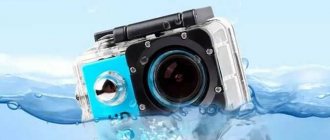Why do you need camera stabilization?
The first photo uses stabilization so it's as clear as possible; The second photo doesn't use stabilization, so it's blurry (photo source: ProPhotos)
Stabilization in a smartphone camera is needed in order to compensate for its movement, avoid blurry photos, as well as annoying shaking in videos. Stabilization is practically irrelevant only if the shooting is done on a tripod and the shutter is released using a remote control. For example, you can remotely control the Camera application on iPhone using the volume buttons on wired and wireless headphones, as well as through the program of the same name on the Apple Watch smart watch. Otherwise, you can’t do without stabilization - the picture will suffer.
By the way, current Apple smartphones are perfect for talking about stabilization. For example, the most popular iPhone 11 has two cameras: wide-angle and ultra-wide-angle. The first is the crown of the manufacturer’s engineering. It takes really high-quality pictures not only due to the relatively large f/1.8 aperture, the relatively large size of the dots on the 12-megapixel matrix, as well as advanced AI algorithms - optical stabilization is also responsible for their clarity. But the second one is here more for show - its aperture is mediocre, and stabilization is only digital.
Using stabilization makes it possible to significantly improve the quality of shooting in the evening, even without a tripod, despite a fairly long shutter speed (photo source: ProPhotos)
Stabilization can be digital, optical, or hybrid - in the latter case we are talking about the simultaneous use of the previous two. Many call stabilization an invisible tripod, which saves photos and videos from the consequences of shaky hands. But it cannot be considered a panacea - yes, it compensates for shaking with a relatively small amplitude. However, if you move quite actively during shooting (for example, dancing), none of the stabilization available on the market will save you. In this case, it will be possible to greatly reduce the shutter speed, but that’s definitely not what we’re talking about today.
Optical stabilization
This is a hardware method for solving image quality problems. To use its capabilities, a special moving mechanism is installed in the smartphone camera, which moves not the image across the matrix, but the entire matrix. To correct the image, sensors are used that determine the oblique displacement and deviation. The information obtained is used to make the necessary shifts for the entire module, as well as the image sensor and lenses.
This function is of high quality in long exposure and low light conditions. However, it affects the aperture ratio, compensates only for slight shaking and is more expensive.
What is digital stabilization and what is the principle of its operation?
A schematic example of using digital stabilization with matrix cropping in a modern smartphone camera - the final image will be inside one of the red rectangles (original photo source: Unsplash)
Digital stabilization is also often called electronic stabilization - it is used only because of its simplicity. It does not require any additional hardware components, which increase both the cost and the further cost of the gadget - only those that are already built into the smartphone are used, and software becomes the basis of the technology. Despite this, even digital stabilization significantly improves the quality of photos and videos, so you need to pay increased attention to it. However, to be fair, it is used everywhere today.
Digital stabilization works similarly to perspective correction from Adobe Photoshop (source: Dallas Thomas/Gadget Hacks) - animation available by clicking
Digital stabilization has a fairly simple operating algorithm. Imagine a smartphone camera matrix, which consists of individual pixels - to simplify, let it be a conventional square of 10 by 10 pixels. When stabilization is turned off, the entire sensor area is used during shooting. After its activation, trimming occurs - instead of 10, a couple of points less are used on each side. Based on data from the gyroscope and accelerometer, an 8 by 8 square moves across the camera matrix to compensate for the shaking of the gadget. That's the whole secret.
The first photo shows an imitation of the use of digital stabilization - not all of the image is included in the frame, but it is clearer; The second photo shows simulated shaking without using digital stabilization - the entire image is in the frame, but it is less clear (original photo source: Unsplash)
The number of points each device actually cuts depends on the aggressiveness of the digital stabilization it uses. After cutting the number of pixels, the image quality also drops - the more aggressive the stabilization is, the stronger it is. However, most often this is justified by the absence of smeared areas. Previously, there was more talk about digital stabilization, but today, without the help of optical stabilization, it is left only in inexpensive smartphones.
Differences from digital stabilization and which is better
A digital stabilizer is essentially a double-edged sword. On the one hand, EIS (DIS) significantly reduces the cost of the gadget, since it does not require additional components for normal functioning. Phones with digital technology will, of course, be cheaper than those with OIS in their cameras.
On the other hand, although smartphones with EIS are used everywhere, they are not able to reduce blur and compensate for shaking as effectively as their counterparts with optical stabilization. As for the differences, cameras with DIS produce photos with cropped edges. The number of dots (pixels) cropped by the device depends on the aggressiveness of the DIS. The more aggressive the work, the more the picture quality drops.
What is optical stabilization and what is the principle of its operation?
Schematic representation of the operation of optical stabilization, in which shaking is compensated by the movement of the camera itself using a special hardware mechanism (original photo source: The Verge)
Despite the fact that not all cameras of modern smartphones use optical stabilization, this technology is far from new - to be more precise, it is at least a quarter of a century old. Back in 1995, Canon began using it in its cameras and lenses. Its version is called Image Stabilization (IS), so other companies had to come up with their own names: Vibration Reduction (VR) for Nikon, Optical SteadyShot (OSS) for Sony, Optical Image Stabilizer (OIS) for Fujifilm. The Nokia Lumia 920 from 2012 is considered to be the first smartphone with an optical stabilization system.
The operating principle of optical stabilization is clear (source: Inam Ghafoor/YouTube) - animation is available by clicking
To use the capabilities of optical stabilization, the smartphone camera uses a special moving mechanism that moves not the image across the matrix, but the entire matrix. As a result, the picture remains sharp, despite the shaking. However, you cannot rely 100% on optical stabilization either. It should be noted that each camera manufacturer has its own ideas about how optical stabilization works, so the quality of the result in the form of a photograph can vary quite a lot. Moreover, camera movement is also limited, so stabilization only compensates for slight shake.
DJI Osmo Mobile 3 is a steadicam for mobile devices that will significantly improve image stabilization (photo source: DJI)
Optical Image Stabilization (OIS)
OIS is a hardware solution that uses a microelectromechanical system (MEMS) gyroscope to detect motion and adjust the camera system accordingly. For example, if you are holding a smartphone and your hand moves slightly to the left, the OIS system senses this and moves the camera slightly to the right.
It's a hardware solution that doesn't require image cropping, meaning the phone uses the full sensor readout to capture the photo. The by-product of this is video with zero distortion, as you don't get the jello effect that comes with digital stabilization. OIS also provides a much more natural-looking video since you are not applying an effect to the video.
Building good OIS hardware doesn't come cheap, which increases the cost of materials and ultimately means you'll pay more for your OIS-equipped smartphone . It also turns a typically static element, the camera module, into another moving part. It's very rare, but sometimes the moving parts of the OIS system may not work properly.
OIS is a useful tool when you're shooting videos or photos. It is especially effective in low light conditions where the camera shutter can be opened longer . Without OIS, this may result in blurry photos due to slight hand movement. With optical image stabilization turned on, mild shake is eliminated for sharper photos. It's the same with telephoto lenses, where the slightest shocks are magnified by the much narrower field of view.
You might like PlayStation 5 - new quality and capabilities
Which is better: optical or digital stabilization
Compared to digital, optical stabilization clearly wins. To begin with, it does not cut off the use of the matrix, so the image is brighter, clearer, with less noise, and so on. Moreover, most often optical stabilization plays out the process of shaking compensation much more correctly, because it does not read data from the gyroscope or accelerometer, but uses its own hardware mechanisms. Optical stabilization is not even used in the newest smartphones - for example, it is in the Xiaomi Mi5, which is already several years old.
Interesting fact: some
They believe
that digital stabilization is better than optical stabilization when shooting video. For example, it is used in the first generation of Pixel smartphones, and Google representatives explain this by the fact that it is able to predict movement, so it compensates for it noticeably faster - this is critical when shooting videos. However, in the second generation Pixel, engineers are already using hybrid stabilization, about which further.
Why is image stabilization needed?
We talked about situations where you don't need image stabilization or vibration control. But in what situations would it be useful to have an image stabilized lens?
- You are photographing stationary subjects in low light. In this situation, IS can help improve your images because you can slow down your shutter speed. It can also allow you to adjust other settings to improve your images, such as closing your aperture for greater depth of field or lowering your ISO to reduce noise in your images.
- You're shooting with a telephoto or super-telephoto lens, but you don't need a fast shutter speed to freeze the action. Instead of setting your shutter speed according to the reverse rule, you can lower your shutter speed a few stops (depending on your IS abilities) without using a tripod.
- You are filming in the wind or, for example, from a vibrating bridge.
- You're shooting a moving subject and need help stabilizing the viewfinder image. Depending on your camera's IS, the image quality may degrade slightly. But this may be preferable to skipping the frame entirely.
- You are shooting video without a tripod. You will definitely notice an improvement in video quality, although this is an inferior replacement for a tripod.
What is hybrid stabilization and what is the principle of its operation?
Google uses hybrid stabilization in Pixel 4 - and in two smartphone cameras at once (photo source: Genk)
A striking example of a smartphone that uses hybrid image stabilization is the Google Pixel 4. It involves combining the capabilities of digital and optical mechanisms, which allows you to make the picture as clear as possible and avoid blur even in the most active shooting conditions. As planned, such a gadget should always use optical stabilization, and connect digital stabilization either using an additional function or independently in an intelligent way. Theoretically, such a mechanism should significantly increase the effectiveness of stabilization.
How does image stabilization work?
Image stabilization in lenses is achieved through the use of a floating lens element. Your camera senses this floating element moving inside the lens. The element is then moved by the lens electronics in the direction opposite to camera shake.
In-camera stabilization works by actually shifting the sensor slightly to account for camera shake.
There is no definitive answer to the question of which is better, lens-based stabilization or in-camera image stabilization. Each has its own pros and cons (this is a separate topic).
The benefit of image stabilization is that it allows you to capture clearer images of stationary subjects with slower shutter speeds than without it. Lens manufacturers rate image stabilization based on what shutter speed you can shoot at with image stabilization.
Let's take a closer look using the Nikon 24-120mm f/4 lens as an example.
Nikon rates vibration reduction capabilities at 4 stops. Without image stabilization, you would have to shoot static subjects at a shutter speed of at least 1/125 to avoid blur in your images from camera shake. With VR enabled on the lens, you can hold the lens and shoot at 1/15 second speed.
This is a powerful thing if you're shooting stationary subjects in low light conditions. Below are two photos, the first was taken with IS image stabilization and the second was without it. It can be clearly seen that image stabilization has helped the image quality.
Which stabilization is better?
Typical mobile photo scenario (photo source: Android Central)
To answer this question, you need to answer this: under what conditions is a photograph usually taken or video recorded on a mobile device? And one more thing: how much does its owner bother to achieve a high-quality picture? The answer is simple - the user wants to receive pictures and videos of maximum quality without putting any effort into it. Hence the rather simple conclusion - the gadget should have the best possible camera that will use hybrid stabilization. By the way, here is a clear example of shooting on the “bearded” Google Pixel 2 with and without it:
The result is obvious: without stabilization the video looks simply disgusting, but with it it is quite suitable for further use. It is worth noting that in this case the conditions are as extreme as possible. On the one hand, it is difficult for the camera due to shaking. On the other hand, it must cover a wide dynamic range due to the rather complex composition of the frame in terms of light. Of course, it’s difficult to say that Google Pixel 2 did a perfect job in this regard, but we’re talking about global picture quality, namely the difference when using hybrid stabilization.
Hybrid Image Stabilization (HIS)
HIS, as the name suggests, is a combination of OIS and EIS. A good universal solution. OIS provides basic hardware stabilization, and then EIS is used to further smooth out the video footage. Thanks to the benefits of OIS, the EIS crop factor does not have to be so extreme. The buffer around the edges of the image can be smaller, resulting in thinner cropping and less impact on the final frame.
In terms of images, the hybrid system does not offer any benefits. The OIS part will ensure shake-free shooting in all desired scenarios . Although EIS could be turned on for added stability with HDR and multiple exposure night shots.
If you're wondering what the results look like, here's an example from the Google Pixel 2, which was the Android giant's first phone to use a hybrid OIS and EIS system:
What are the prospects for stabilizing mobile device cameras?
VIVO APEX 2021 concept phone, which uses a camera with a highly upgraded optical stabilization mechanism (photo source: Matrix Life)
There are three equivalent development paths for image stabilization in smartphone cameras. Firstly, its optical mechanisms are becoming more and more accessible, therefore they are increasing the width of their distribution not only in smartphones, but also in the cameras in them - so, you see, all the modules of future iPhones will work with it. Secondly, more advanced optical stabilization mechanisms will appear, which are already appearing in concept phones - the same VIVO APEX 2020 (it uses a gimbal stabilization mechanism that increases the amplitude of camera movement to compensate for even the most aggressive shaking). Thirdly, we cannot throw aside intelligent software mechanisms that continue to develop.
What if hybrid isn't enough?
If you are still unhappy with the smoothness of video recording on your smartphone, the last trick is to use a stabilizer. Essentially, these are large gyroscopes that, when balanced correctly, keep your phone in one orientation . Motors are used to counteract the movement of your hands, moving the camera in the opposite direction. However, the results are not always better than your smartphone's image stabilization.
You might like TOP 10 smart watches 2021: proven tips on how to choose the best
Are smartphone gimbal stabilizers better than OIS?
Gimbals provide the added benefit of allowing you to control the motors to create smooth pan and tilt movements. Typically, a joystick is built into the handle, allowing the user to control the movements of the stabilizer. These pendants cost from 6,000 to 10,000 rubles, depending on the brand, model and set of accessories. That's quite a lot of money for something that definitely won't fit in your pocket.
OPTICAL IMAGE STABILIZATION
Optical stabilization is a technology implemented in the lens , not the camera. The giants of photography, Nikon and Canon, almost simultaneously began research in the field of optical stabilization. And in 1994, Nikon introduced the first film camera, the Nikon Zoom 700VR , with optical image stabilization built into the lens, and in 1995, Canon introduced the EF 75-300mm F4-5.6 IS USM , the world's first lens equipped with optical image stabilization.
The principle of operation was that an additional optical stabilizing element is added to the lens design, which is deflected by the electric drive of the stabilization system so that the projection of the image on the film (or matrix) completely compensates for camera vibrations during shooting.
We remember that photography is drawing with light that passes through the lens, is refracted by the lens of the lens and projected onto a light-sensitive element (matrix or film). If the correct shooting parameters are not met and the shutter speed is longer than necessary, and you take photographs handheld, then the projection of the image falling on the matrix shifts due to camera vibration, and the image turns out blurry.
So, thanks to the stabilizing element, the projection always remains motionless relative to the matrix, which provides the picture with the necessary clarity. But this technology also has a drawback - the additional optical element slightly reduces the lens aperture . The second obvious drawback is that, other things being equal, lenses with built-in image stabilization are more expensive .
Below are the designations used by manufacturers to identify the image stabilization built into lenses :
- Nikon Vibration Reduction - VR
- Canon Image Stabilization - IS
- Panasonic Lumix Optical Image Stabilizer OIS (There are varieties - POWER OIS and MEGA OIS )
- Olympus Image Stabilization - IS
- Sony Optical Steady Shot - OSS
- Tamron Vibration Compensation - VC
- Sigma Optical Stabilization - OS
- Samsung Optical Image Stabilizer - OIS
- Fujifilm Optical Image Stabilizer - OIS
As you noticed, some manufacturers may have different types of optical stabilizers, such as POWER OIS and MEGA OIS from Panasonic . So, let's figure it out:
Initially, the first optical stabilizers were biaxial - that is, they shifted the image projection along two axes of the plane - horizontal and vertical and could compensate for fluctuations when using a shutter speed that was 1-2 steps longer than possible.
Let's look at an example : when using a lens with a focal length of 100 mm, the minimum shutter speed that can be used to obtain a sufficiently sharp image should be shorter than 1/100 of a second (this is for a full sensor, and if the camera has a crop sensor, then you need to take into account - equivalent focal length). But, if the lens uses a stabilizing element, the shutter speed can be made shorter without compromising image quality (1 stop is a 2-fold reduction in shutter speed, 2 stops is a 2*2=4! times reduction). That is, you can set the shutter speed up to 1/25 second.
But progress does not stand still, and today manufacturers offer in their products much more advanced stabilizing elements that can compensate for shutter speed by 3-4 and even 5 steps (that is, reduce shutter speed by 8-16-32 times, respectively).
In addition, technologies with 4-axis stabilization elements have appeared, which make it possible to compensate not only hand tremors and horizontal / vertical shifts, but also axial movements of the lens and strong shaking when walking. This is significantly helpful when shooting macro photography and hand-held video shooting with a digital camera.
As an example, Panasonic 's MEGA OIS is a two-axis stabilization with vibration compensation up to 2-3 steps, and POWER OIS is a four-axis system that, in addition to compensation up to 3-4 steps, is also capable of dampening vibrations when shooting handheld videos while walking. Other manufacturers also have similar technologies - for example, Hybrid IS and Dinamic IS from Canon .
Hybrid Image Stabilization or HIS
From the name it is clear that hybrid stabilization is a kind of combination of OIS and EIS - a pretty good solution. OIS provides basic hardware stabilization while EIS is used for post-smoothing of video footage. Thanks to the presence of optical stabilization, the operating parameters of EIS are being revised: the buffer at the edges of the picture may be smaller, which means thinner framing and less impact on the final result.
For photography, the hybrid system does not bring any benefit, since optical stabilization is responsible for the quality of shooting in any scenario. Although EIS can be turned on for additional stability, for example, for creating night shots.











